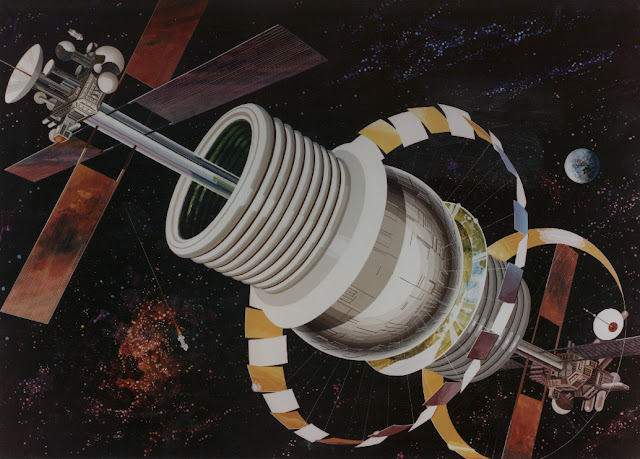I needed a plausible space station for my fictional characters to live in. My research yielded such riches, I decided to share them
with you in a series of “Space Station DIY” blog posts.
 |
| John Desmond Bernal |
Today, let’s consider the Bernal Sphere. It’s an idea originally
cooked up by John Desmond Bernal in 1929. Bernal was primarily known as a
pioneer in molecular biology, but his concept of a spherical habitat in space
seemed plausible enough for NASA to launch a more in-depth study in 1975-76.
 |
| Gerard K. O'Neill |
That study led to Dr. Gerard K. O’Neill’s proposal for
Island One, a relatively small Bernal Sphere. This was followed by the larger
Island Two (which, it was hoped, would provide a more practical industrial
base). By the time O’Neill got to Island Three, he’d evolved to a different
shape, the O’Neill Cylinder (we’ll discuss that design in a future post). Other
research rooted in the Bernal Sphere eventually led to a toroidal design, often
called a Stanford Torus.
 |
| The wine-tasting party doesn't seem to mind if the world is inside-out. |
What would it be like, to live in a Bernal Sphere? Artwork from the mid-1970s gives us a glimpse of an inside-out world, in which you
could see the other side of the colony “up in the sky.” I don’t know about you,
but I think that would give me terrible vertigo.
 |
| Recreation at the poles: nets and micro-gravity sex? |
The artificially-generated centrifugal gravity would fall to
nothing at the poles, which some have thought would make those good
recreational areas. The illustration above envisions “Zero gravity honeymoon suites,” but doesn’t seem to consider the problems of space-sickness caused by
microgravity, or the realities of Newton’s Third Law. Perhaps people would be
better advised to enjoy their marital bliss in the 1-G areas, and play Quidditch at
the poles.
 |
| Perhaps people could play Quidditch at the poles of the Bernal Sphere. |
The outside view shows a series of rings on one end, stacked
next to the sphere. This would be the so-called “Crystal Palace” for
agriculture to feed the population of 10,000 (on Island One).
 |
| External view of Island One, with agricultural "Crystal Palace" tori at one end. |
Unfortunately, scientists and engineers in the 1970s were
not much concerned about the issues involved in intensive farming, so they followed
contemporary ideas, and designed their Crystal Palace to be a cow-, pig-, and chicken-hell. I wonder how much concern they had about
overuse of antibiotics and methane production (perhaps they could use the latter as a fuel, but what about the smell?), as well as the relative economies of growing plant crops versus livestock. Maybe they just couldn't imagine life without steak?
 |
| Livestock Hell in space? Maybe not such a good idea after all. |
Ultimately, I decided the Bernal Sphere was not the design for my fictional space
station. If I didn’t want to imagine living there, why would I try to make my characters do so? Might recall O'Neill apparently moved away from the original sphere-focused idea, too, once he looked into it more. But although my fictional Rana Habitat Space Station didn't turn out to be a Bernal Sphere, the design gave me some interesting ideas. I hope you've enjoyed this exploration.
Earlier posts in this series have discussed space stations in popular culture and conjecture, and the idea of Dyson spheres.
IMAGES: Many thanks to the ever-invaluable Wikipedia, for the photos of John Desmond Bernal and Gerard K. O'Neill; to the NASA Ames Research Center for the 1970s-era artwork of the Bernal Sphere interior, exterior, and "Crystal Palace" cutaway detail; to the National Space Society, for the artist's rendering of the Bernal Sphere recreational area; and to Entertainment Weekly for the Harry Potter Quidditch image. I appreciate all of you!
No comments:
Post a Comment